4.1 INTRODUCTION
The objective of this chapter is to describe the stratigraphic sequence of the Douara Cave deposits excavated in the 1984 season, and to present the results of the geological study and more particularly of the sedimentological study applied to the cave deposit.
The objective of the 1984 excavations at Douara was to unearth the sequence of hearth deposits that had been designated IVB in the 1974 excavations. These hearth deposits, about 6 m × 4 m wide, were encircled by limestone fragments and a series of very compact concretions. The longer axis of the hearth was parallel to the orientation of the cave.
The area excavated in 1984 was first trenched along the line X=8. The deposits found in this trench were divided into a unit column having a square cross-section of 1 m× 1 m, in accord with the master grid plan for the site. These squares were then divided vertically at intervals of 10 cm. The trench was excavated to Z=240 cm from the datum level at the deepest part (grids 8-04, 05, and 06), or about 70 cm below the bottom level of the 1974 season excavation.
In 1974, line X=8 was excavated down to Z= 160 cm. But when the overlying debris was removed at the beginning of the 1984 season's excavation, it was found that the bottom level of the last season's excavation was sloping towards the entrance of the cave, and the true level was Z=160 to 180 cm (Fig. 4. 1). The sediments in the cave had apparently been compacted during the ten years it had been left, especially the soft ash layers around grid 8-07. Abrasion of these soft ash layers may also have occurred when the overlying debris was removed.

Fig.4.1 |
Consequently, the deposits excavated in 1984 were subdivided into three units-IVB, IVC, and IVD from top to bottom according to color, homogeneity, hardness, compact ness, and stickiness (Plate 4. 1). These three units were all hearth deposits.

Plate 4.1 |

4. 2 STRATIGRAPHY OF THE DEPOSITS EXCAVATED DURING THE 1984 SEASON
4. 2. 1 Unit IVB
The stratigraphically delineated IVB is found in all the grids excavated during this season except in grids 8-02, 8-03, and 9-04. This unit slopes slightly (about 5°) towards the
entrance of the cave, and also dips (about 25°)from line X=9 to line X=7. The unit is deposited most deeply around grids 8-05 and 8-06; the depth there, added to that of the last season's excavation, reaches about 100 cm.
IVB is characterized by an alternating white and gray ash layer, with additions of blackish charcoal lenses about 1-2 cm thick. The unit is further subdivided between an upper whitish part about 15 cm thick and a lower bluish part about 5 cm thick (Fig. 4. 1). A black or blackish brown band thinner than 1 cm separates these two parts. This black band contains many carbonized plant remains, especially near the boundary of the lower bluish part in grid 9-07 where a lot of fragments and non-broken spherical plant remains 4 mm in diameter are densely aggregated.
The upper whitish part of the unit is very soft and homogeneous, which compacts when it is wet but is very fine and light when dry. The lower bluish part is well represented in grids 8-06 and 8-07, but is obscured in grid 8-05. The bluish part is made of the same material as the upper whitish part, but is slightly more concrete and flaky. There are many carbonized plant remains and "soil minerals" (which will be treated in section 4.3.3) in this part of the unit. The boundary between the bluish part of the unit and the underlying level IVC is relatively clear: it consists of a very thin film (thinner than 1 mm), yellowish orange to white in color. This film could show that the lower bluish part was affected by heat either rather strongly or for a long time.
In the upper whitish part of the unit in grid 9-05, a burnt barite 5 cm in diameter with cracks on its surface was found. In the deposits of "disturbances" (as described in suc ceeding section 4.2.4) in grids 8-05 and 9-05, two barites 4 cm and 5 cm in diameter were also found. These two barites are thought to have originally been in IVB. One of these barites is also burnt, and broken into a few pieces. These cracked or broken barites also suggest that IVB was affected by heat
4. 2. 2 Unit IVC
Unit IVC is found in all of the grids except 8-02, 8-03, and 9-03. This level is about 15-25 cm thick, and also slopes towards the entrance of the cave and line X=7, which is almost parallel with the overlying IVB. The deposits in this unit are generally harder than the deposits in IVB. They are also gray to brown in color and not as homogeneous as the deposits in IVB. Many burnt plant remains, 2-3 mm in length, have been excavated in this unit, and some unbroken spherical plant remains were also found, Many plant re mains and the other small, thin particles, such as blackish broken pieces of flints, lean in the same direction as the layer. This unit also contains many soil minerals which are distributed evenly in general, but are not found close together in some places.
IVC is subdivided into two parts, the upper grayish part and the lower dark brown part, by color, roughness, and soil minerals.
The upper grayish part is 15-20 cm thick and the lower dark brown part is 5-10 cm thick. Around the boundary between these two parts, thin lenses or bands of blackish charcoal can be seen, similar to those in IVB. Many more plant remains are present in the lower part than in the upper part and the sediments of the lower part seem to have been deposited more roughly.
Grids 8-05 and 8-06 show a detailed sedimentological structure in which small lens deposits lie one upon another. But in grid 8-07, the deposits are not clear and seem to have been disturbed or removed.
4. 2. 3 Unit IVD
The stratigraphic Unit IVD can be recognized under Unit IVC in the vertical section of the line X=8; it is about 30 cm thick. Just after excavation, when the deposit was wet, it was pale yellow in color, and so compact that it could be only slightly dented by pushing with a finger against it strongly. When dry, the unit turns very hard and white.
In IVD there are brown or gray lenses and gray bands similar to the deposits in IVC. IVD also slopes slightly toward the entrance of the cave, like the overlying layers. There is less plant remains in this unit than in IVC, but there is some granule-sized rubble.
IVD corresponds approximately to Layer F designated in the 1970 excavations, which was described as a large uniform layer of whitish calcareous concretions, cemented tightly by silty sand and small amounts of limestone (Akazawa et al., 1973). IVD seems to be continuous along the cemented sidewall of the channel-like depression in grids 8-07 and 7-07, which is mentioned in the previous report (Akazawa et al., 1973).
In grids 8-03 and 8-04, the deposit next to IVD is partially revealed, but IVD is the lowest level in grids 8-05 to 8-07, and was not excavated in grids 9-03 to 9-07. Therefore, detailed information about this level, such as its relation to the boundary of the hearth ash deposits, is not available, though it may be obtained in further excavations.
4. 2. 4 Disturbances
Light brown and very loose deposits shaped like ellipses can be observed in the vertical section of line X=8, and are found in many other places. These deposits are in moles' tunnels, and are about 2-15 cm in diameter. The tunnels run in all directions throughout the excavated areas.
These deposits contain plant and small animal remains and rubble. More than 40 percent of the animal bones found in the 1984 season were located in these areas. Most of the bones from this section are yellow or light brown, with no trace of burning. This contrasts with the remains found in IVB, IVC, and IVD, which are brown and appear to be burnt.
These facts suggest that the "tunnel-like" deposits are not primary hearth ash but are the product of animal activities or some other disturbance that occurred after the deposition of the hearth ash.
4. 3 GRAIN-SIZE DISTRIBUTION AND THE CHARACTERISTICS OF SMALL PARTICLES
The deposits excavated during the 1984 season were all the hearth ash deposits, except for the "disturbances". The excavated deposits contain various kinds of small particles, such as burnt plant remains, granule-sized rubble, ash concretions, and soil minerals. Most of the small particles are all less than 4 mm in diameter, with the exception of pieces of flint and a few animal bones.
To determine the grain-size distribution and how many small particles were included in each layer, twelve samples were systematically taken: three samples from Unit IVB, four from Unit IVC, three from Unit IVD, one from the "disturbance", and one from a "Nebkha" near location 122 (see Chapters 1 and 2 in this volume) as a control to compare with the samples in the cave site. The samples from the hearth deposits in the cave site were taken from the south side of the line X=8 (see Fig. 4. 1).
Each of the samples are about 130 cm3 in volume and about 50 grams in weight. They
were dry sieved by a machine for ten minutes. The size grades used in this analysis are 4-1 mm, 1-0.5 mm, 0.5-0.25 mm, 0.25-0.125 mm, 0.125-0.063 mm and smaller than 0.063 mm. Small particles, between 4-1 mm in diameter, were separated into four groups: plant remains, soil minerals, granule-sized rubble, and ash concretions. Granule-sized rubble and ash concretions were only about 0.1M of the weight of each sample.
4. 3. 1 Grain-size distribution
The results of analysis of the grain-size distribution are shown in Figs. 4. 2 and 4. 3. Almost all the hearth ash deposits (numbers  to to  ) consist of sand size fractions, ranging towards medium and fine sand (phi scale 0 to 4) which comprise 69% to 86% of each sample (Fig. 4. 2). But some clear differences among the three stratigraphic units can be seen in the grain-size distribution curves (Fig. 4. 3). ) consist of sand size fractions, ranging towards medium and fine sand (phi scale 0 to 4) which comprise 69% to 86% of each sample (Fig. 4. 2). But some clear differences among the three stratigraphic units can be seen in the grain-size distribution curves (Fig. 4. 3).
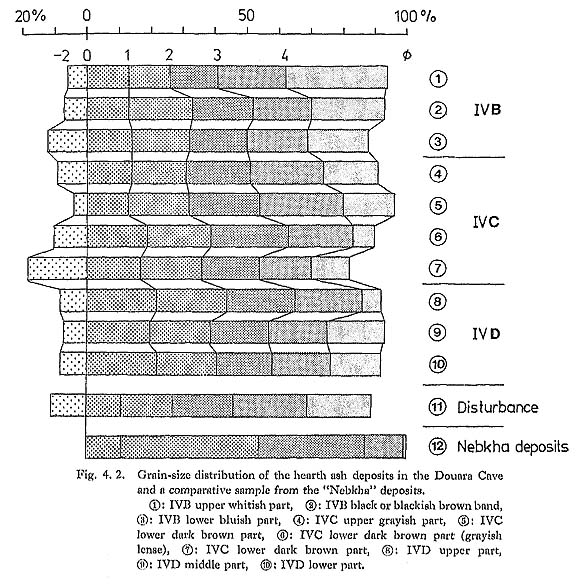
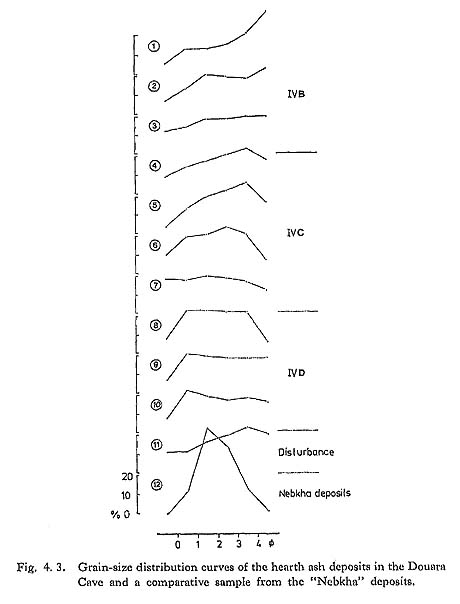
The grain-size distribution curves of IVB (No. 1 to No. 3) generally rise to the right, which means that IVB is composed of much finer fragments. This is especially true of the upper white part of IVB (No. 1), in which 32% of the samples are smaller than 0.063 mm.
The grain-size distribution curves of IVC, except for sample No. 7, also rise to the right, but the silt or clay size fraction is very small. The fine sand size fraction (phi scale is 2 to 4) occupies a very high proportion (43-48%) of the samples. Sample No. 7 was taken from the lower dark brown part of IVC in grid 9-07, where coarse fragments such as the burnt plant remains and soil minerals bigger than 1 mm make up a large part of the sample.
The grain-size distribution curves of the samples from IVD are flat, with each end drop ping down. The medium and fine sand size fractions are predominant, with coarse and fine fractions making up a small amount of this unit.
The grain-size distribution curve of the sample from the "disturbance" is very similar to the sample from the upper part of IVC (No. 4), where the fine sand size fraction is predominant. But the "disturbance" includes many other materials, such as burnt plant remains, granule-sized rubble, soil minerals, and small animal bones, which differ greatly from the other hearth ash deposits.
The sample from the "Nebkha" deposits is composed of 43% medium sand (0.5-0.25 mm) and 33% fine sand (0.25-0.125 mm), which is a remarkable contrast to the samples from the hearth ash deposits in the cave.
4. 3. 2 Plant remains
Many plant remains were found in each layer, through the upper whitish part of IVB to the lower part of IVD. As mentioned in the previous sections (4. 2. 1 and 4. 2. 2), much more plant remains occur both in the lower bluish part of IVB and in the lower dark brown part of IVC. In fact the plant remains are so dense in these parts that the coarse sand size fraction reaches a relatively high proportion (Fig. 4. 2). But in the upper whitish part of IVB and IVD, except for the gray lenses and bands, only a few plant remains were found, and these two parts have a relatively finer fraction. In the gray lenses and bands in IVD, just as many plant remains were found as in the lower bluish part of IVB or in IVC.
Several statements can be made: 1) a layer which looks gray or brown includes many plant remains and is composed of relatively coarse materials; 2) a layer which is white or pale in color has few plant remains and is composed of relatively fine materials.
Almost all the plant remains removed from the hearth ash deposits in this season were gray or light gray except for the middle and lower parts of IVD, where whiter and thinner plant remains were found. Detailed information about the plant remains is contained in chapter 7 of this volume.
4. 3. 3 Soil minerals
From the lower bluish part of IVB to the upper part of IVD, there are many spherical grains ranging in size from coarse sand to granules (Plates 4. 2, 4. 3, 4. 4). They are white or pale yellow to gray in color, but none of these grains can be seen in the upper whitish part of IVB and the lower part of IVD. In the black band of IVB, a few of these types of grains are found. These grains are scattered almost equally, and are not concentrated at any one place in each layer. Their size, color, roundness, and the other characteristics are unique for each layer. They can easily be picked up individually by tweezers and are not broken by the sieving process, but can be crushed with a finger.
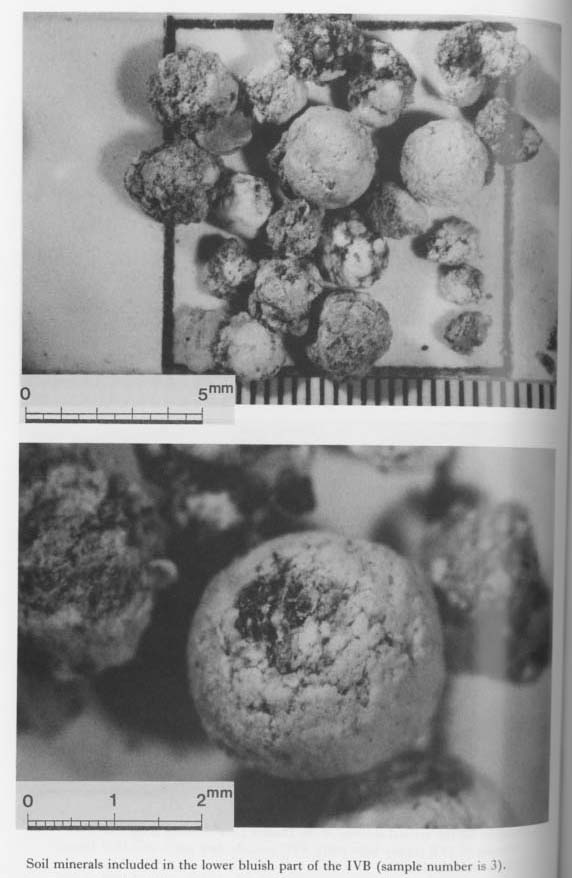
Plate 4.2 |
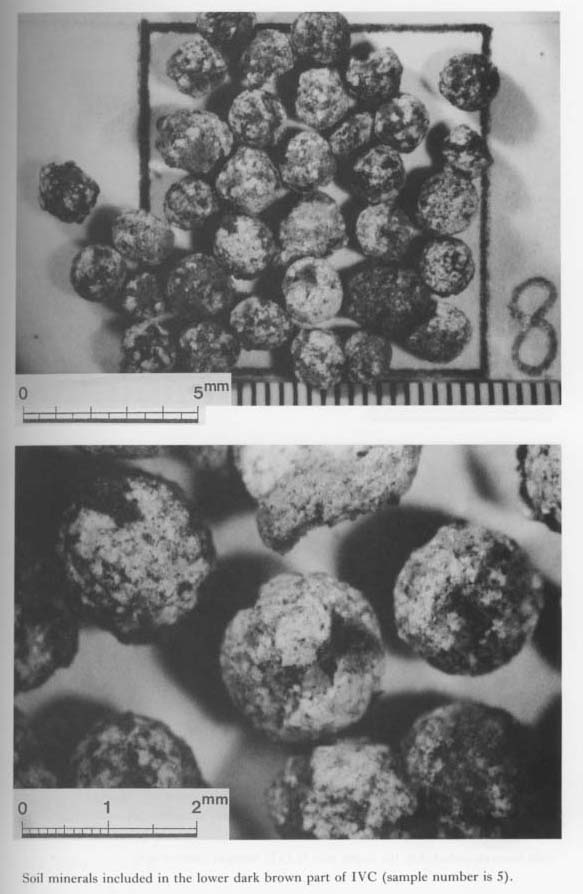
Plate 4.3 |
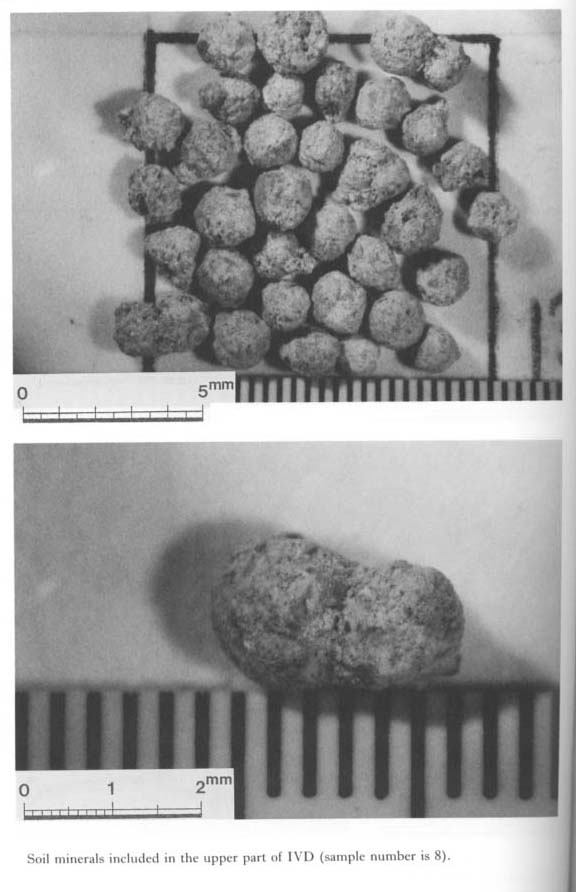
Plate 4.4 |
These grains are thought to be "soil minerals", and have been analyzed via X-ray dif fraction by Dr. Akira Kato (Department of Geology, National Science Museum, Tokyo) using the powder method. The X-ray powder patterns of grains from each layer are very similar, and give a generally smooth curve with some slight peaks representing mont morillonite (M), quartz (Q), and apatite (A) (Fig. 4. 4). Montmorillonite is a type of clay mineral. When a grain of soil mineral is observed under a microscope, small fragments of plant remains are often agglutinated by fine powdery material. The peaks of quartz or apatite indicate that some small fragments of quartz rubble or small animal bone are in cluded in each soil mineral as its nucleus.
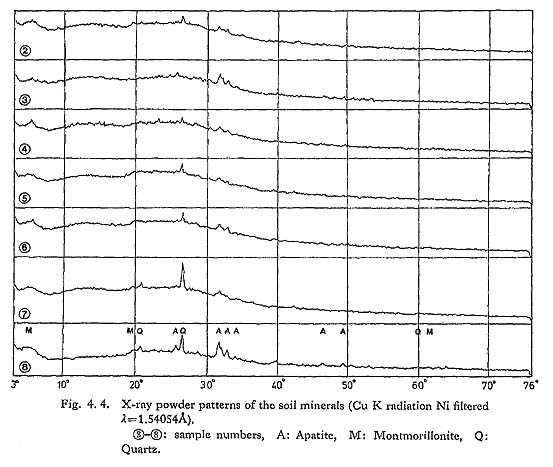
The grain-size distribution of the soil minerals is shown in Fig. 4. 5. As many soil min erals as possible were picked out from each of the samples used in the former analysis (see Section 4. 3. 1). Eight mesh grades were used, from-2.0to 0.0 at intervals of 0.25 on the phi scale.
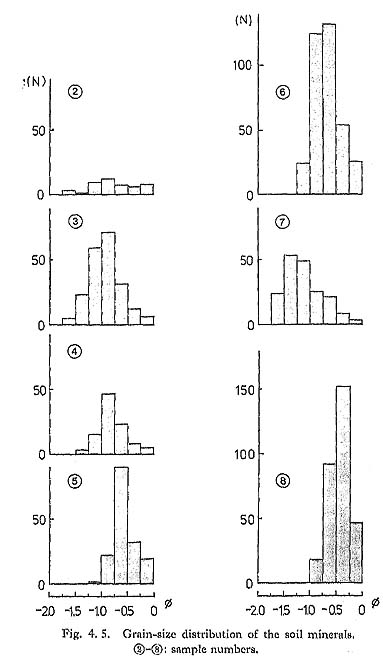
The number of soil minerals in each of the samples vary from 46 to 357. The lower gray band of IVC (No. 6) has the largest number of soil minerals (357 grains). Next largest number comes from the upper part of IVD (No. 8; 309 grains). The mean grain size of each sample is -0.43 (1.3 mm) to -1.20 (2.3 mm.) on the phi scale. The samples from the lower part of IVC in grid 9-07 and the lower bluish part of IVB contain larger soil minerals, and both samples also contain a large number of plant remains. The sorting coefficient (σ1=1/4 (φ84-φ16)+1/6.6 (φ95-φ5): Folk and Ward (1957)) is between 0.19 and 0.46; that is, soil minerals of each layer are considerably uniform in size. The upper part of IVD (No. 8) is the best of all the samples: almost half of the soil minerals are distributed be tween-0.25 (1.2 mm) and -0.50 (1.4 mm) on the phi scale.
4.4 STRATIGRAPHY
4. 4. 1 Middle Paleolithic hearth and its deposits
The deposits excavated during this season were all hearth deposits, distributed in the shape of an ellipse centering on grids 8-05, 8-06, and 8-07. Each ash layer (IVB, IVC, or IVD) had black or brown charcoal lens and bands and dipped towards the entrance of the cave and the trench between line X=7 and line X=8 (see Fig. 4. 1). Consequently the hearth deposits are especially thick (about 140 cm) around grids 8-05, 8-06, and 8-07.
The relation between the margin of this hearth and its deposits is not clear yet. But in the horizontal section at Z=60 cm, IVD is found inside an arrangement of limestone rubble and a hard rugged surface of concretions, which is thought to be the margin of the hearth. In grid 8-04, under IVD, a grayish. yellow or grayish brown layer, 5-10 cm thick, with small spots of yellow or white ash can be seen. This thin layer is sticky, dirty and not homogeneous. It changes to a very hard, concrete ash layer in grids 8-02 and 8-03, which seems to be a part of the hearth wall.
Based on these observations, IVD is thought to be the lowest or nearly lowest layer of the hearth deposits.
4. 4. 2 Small particles in the hearth deposits
The hearth deposits include various kinds of small particles, such as plant remains, soil minerals, small rubble, small animal bones, black charcoal flakes, and ash concretions. Table 4. 2 shows how many of these small particles are contained in each layer.

Our findings on plant remains and soil minerals will can be summarized as follows;
1) The black or brown band and the lower bluish part of IVB (samples No. 2 and No. 3) and the lower brown part of IVD (No. 7) contain more plant remains than the other samples. On the other hand, soil minerals are relatively abundant in the lower bluish part of IVB (No. 3), the lower dark brown part of IVC (No. 6 and No. 7) and the upper part of IVD (No. 8).
Samples No. 3 and No. 7 contain so many plant remains and soil minerals that the percentage of soil materials larger than 1 mm is quite high. Sample No. 2 includes many plant remains but few soil minerals. In contrast, samples No. 6 and No. 8 have many soil minerals and few plant remains. There is no clear relation between the volume of the plant remains and the number of soil minerals. But, in relation to the medium diameter of the soil minerals in each sample, the following points are noteworthy: samples No. 7 and No. 3, in which the medium diameter of the soil minerals is greater than that of the others, contain more plant remains. Sample No. 8 with the smallest medium diameter of the soil minerals, has few plant remains. This evidence, plus the fact that small plant remains are agglutinated by fine powdery material (mentioned in section 4. 3. 3), indicates that the frequency of plant remains affects the size of the soil minerals.
2) The medium diameter (Md) and the sorting coefficient (oi) of the soil minerals in each sample are closely correlated (correlation coefficient γ=0.98) (Fig. 4. 6). Sample No. 2 was not included in this calculation because the number of soil minerals (46 grains) was in sufficient.
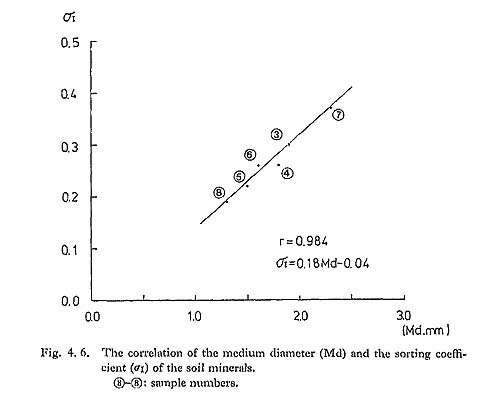
The author thinks that the development of soil minerals is influenced by the underground water and that variations in the number, grain size and sorting coefficient of the soil min erals in each layer are a result of differences in the micro environment of each layer. An understanding of the formation and development of the soil minerals and their relation to the micro environment awaits further study.
LITERATURE CITED
- Akazawa, T., H. Baba and K. Endo (1973)
- Investigation of the Douara Cave Site, 1970 Season. In Suzuki and Takai (eds.), The Palaeolithic Site at Douara Cave in Syria. Part I. Univ. Mus., Univ. Tokyo, Bull. 5: 9-27.
- Endo, B., T. Fujimoto, T. Akazawa and K. Endo (1978)
- Excavation at the Douara Cave. In Hanihara and Sakaguchi (eds.), Paleolithic Site of Douara Cave and Paleogeography of Palmyra Basin in Syria. Part I. Univ. Mus., Univ. Tokyo, Bull. 14: 83-98.
- Endo, K. (1973)
- Sedimentological analysis of the Deposits in the Douara Cave Site. In Suzuki and Takai (eds.), The Palaeolithic Site at Douara Cave in Syria. Part I. Univ. Mus., Univ. Tokyo, Bull. 5: 89-111.
- Endo, K. (1978)
- Stratigraphy and Paleoenvironments of the Deposits in and around the Douara Cave Site. In Hanihara and Sakaguchi (eds.). Paleolithic Site of Douara Cave and Paleogeographym of Palmyra Basin in Syria. Part I. Univ. Mus., Univ. Tokyo, Bull. 14: 53-81.
- Folk, R. L. and W. Ward (1957)
- Brazos river bar; a study in the significance of grain size param eters. J. Sed. Petrol., 27: 3-26.
|